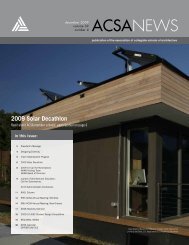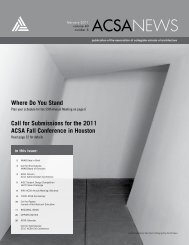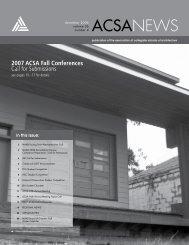digital aptitudes - Association of Collegiate Schools of Architecture
digital aptitudes - Association of Collegiate Schools of Architecture
digital aptitudes - Association of Collegiate Schools of Architecture
You also want an ePaper? Increase the reach of your titles
YUMPU automatically turns print PDFs into web optimized ePapers that Google loves.
SATURDAY, MARCH 3, 2012 - 12:30PM - 2:00PM<br />
Technology Continued<br />
CFS - Cross Fabricated Scales<br />
Wendy Fok, University <strong>of</strong> Houston<br />
Sue Biolsi, WE-DESIGNS.ORG<br />
Cross-Fabricated Scaled is an investigative prototype <strong>of</strong> experimental<br />
cross-fabrications between geometry and materials research, serving<br />
as a crossover between architecture and art—with a high concentration<br />
on the developmental nature <strong>of</strong> experimentation and details, relating<br />
to the scalability <strong>of</strong> a singular, yet repeated, patterning unit.<br />
The emphasis <strong>of</strong> this piece is the seamless transition between scales<br />
<strong>of</strong> a composite geometry, which is an evolution <strong>of</strong> topologies, exploring<br />
the physical properties intrinsic within the technique <strong>of</strong> <strong>digital</strong> and<br />
analog design experimentations. In fostering the synthesis <strong>of</strong> repetition<br />
and variation within a scalable logic, Cross-Fabricated Scaled<br />
anchors its design experimentation in exploring the challenges <strong>of</strong><br />
producing a continuous surface condition through a composite unit<br />
which has the ability to seamlessly scale up through the minimized<br />
connection <strong>of</strong> parts.<br />
The form-finding investigation and evaluation included active lab<br />
testing <strong>of</strong> physical models, in conjunction with computer simulation<br />
and optimization processes through a CNC (3D) milled prototype <strong>of</strong><br />
each individual module, which attaches to a framing system. In addition,<br />
the fragility <strong>of</strong> the forms and differentiated materials were conceptually<br />
assessed through experimentation during the design development<br />
research process.<br />
The final [whole] wall is constructed <strong>of</strong> modular self-supporting aggregates<br />
that seamlessly unite through a minimal connection <strong>of</strong> parts,<br />
creating a gradient <strong>of</strong> tessellation across scales. The collective units<br />
could possibly scale ad infinitum, yet the perception <strong>of</strong> its parts is<br />
diffused through its design that expresses a maximum variation for a<br />
minimum amount <strong>of</strong> parts, which also allows for ease <strong>of</strong> transportation<br />
and construction. In order to fully express the effect <strong>of</strong> the scalar<br />
transition, the repeated units are best viewed as a formalized wall partition<br />
system, which can divide or constructed within a taciturn space.<br />
Climate Changes: Thermal Response Verification <strong>of</strong><br />
a Building Envelope Using Transient Heat Transfer<br />
Analysis<br />
Kyoung-Hee Kim, University <strong>of</strong> North Carolina at Charlotte<br />
The rapid expansion <strong>of</strong> the world’s economies demands enormous<br />
consumption <strong>of</strong> fossil fuel and construction materials. According to<br />
2011 Energy Information Administration Data, world marketed energy<br />
consumption grows by 53 percent from 2008 to 2035. The rapid<br />
growth and increasing emissions <strong>of</strong> greenhouse gas are expected to<br />
accelerate global climate change. Scientists expect that the average<br />
global surface temperature could raise an additional 1 to 4.5° F within<br />
the next 50 years which are attributed by both human and natural<br />
causes.<br />
The environmental impacts <strong>of</strong> a building are alarming and it is important<br />
to understand how global warming in future is going to<br />
affect the energy performance <strong>of</strong> a building. Certainly, there are<br />
many building systems that can play a role in implementing sustainable<br />
concepts and mitigating impacts from climate changes.<br />
Among various building systems, a building envelope system - an<br />
immediate mediator between outdoor and indoor climate conditions<br />
– requires through understanding <strong>of</strong> its response to climate<br />
changes. The primary purpose <strong>of</strong> the presentation is therefore to<br />
address the impact <strong>of</strong> climate changes on the energy performance<br />
<strong>of</strong> building envelopes and further on the built environment. As a<br />
pilot study, a transient heat transfer analysis using finite element<br />
modeling was used to simulate the thermal response <strong>of</strong> a building<br />
envelope based on hourly recorded weather data in Charlotte.<br />
Further, the presentation also will discuss about challenges and opportunities<br />
using transient heat transfer analysis method in class or<br />
seminar environments as an efficient learning tool to visualize the<br />
dynamic nature <strong>of</strong> the built environment. Detailed analysis results<br />
will be presented in the conference meeting.<br />
Electropolymeric Dynamic Daylighting System:<br />
DisPlay Technology for Bio-responsive Mediated<br />
Building Envelopes<br />
Bess Krietemeyer, Rensselaer Polytechnic Institute<br />
Increased awareness <strong>of</strong> the negative effects that limited natural<br />
light exposure has on the human circadian rhythm has drawn attention<br />
to the role <strong>of</strong> daylight in buildings. Human health and energy<br />
problems associated with the lack <strong>of</strong> control <strong>of</strong> natural light<br />
in contemporary buildings have further necessitated research into<br />
dynamic windows for energy efficient buildings. Existing dynamic<br />
window technologies have made moderate progress towards<br />
greater energy performance for curtain wall systems but remain<br />
limited in their performative response to dynamic solar conditions<br />
and variable user requirements for thermal and visual comfort. In<br />
contrast to existing façade technologies, emerging display technologies<br />
could actively reconfigure their basic patterns to respond<br />
to fluctuating bioclimatic flows while simultaneously adjusting to<br />
the changing visual desires <strong>of</strong> its occupants. Recent breakthroughs<br />
in the field <strong>of</strong> information display provide opportunities to transfer<br />
emerging display technologies to building envelopes that can<br />
achieve high levels <strong>of</strong> variety and control over the passage <strong>of</strong> solar<br />
radiation with immediate switchability. Electroactive polymers are<br />
one such emerging technology that, when deployed within insulated<br />
glazing units (IGUs), could significantly increase the range<br />
<strong>of</strong> solar heat gain coefficient, U-value and visible transmittance for<br />
windows. Integrating electroactive polymers within the surfaces<br />
<strong>of</strong> an insulated glazing unit (IGU) could dramatically improve the<br />
energy performance <strong>of</strong> windows while enabling user empowerment<br />
through the control <strong>of</strong> the visual quality <strong>of</strong> this micro-material<br />
assembly. The Electropolymeric Dynamic Daylighting System<br />
(EDDS) is a dynamic glazing technology that could respond to<br />
Digital Apptitutes + Other Openings - Boston, MA - 55








